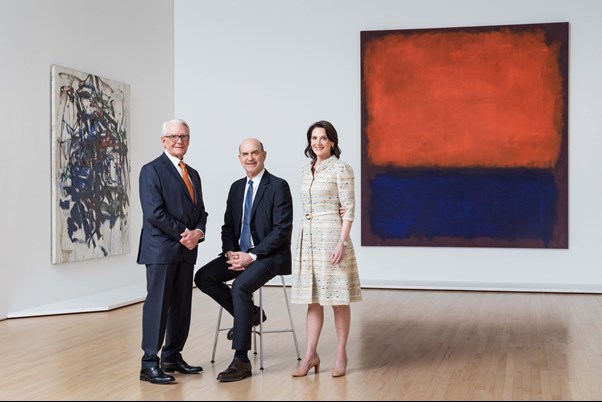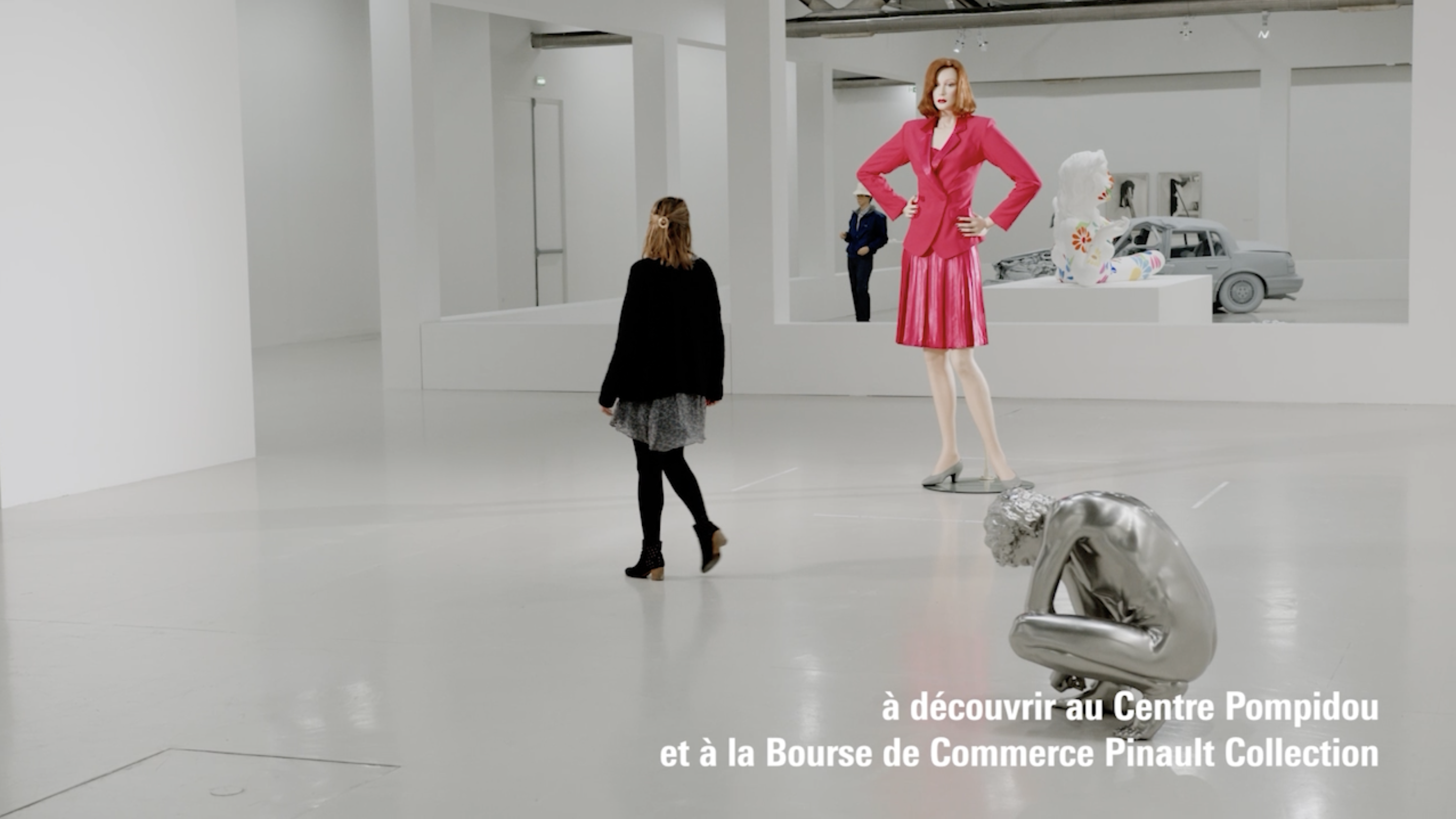Patronage: as artists, we may not be directly involved, but we do observe a number of developments up close.
I will mention a few by way of illustration, more or less extensively. Much of the information below can be found on the website of the institutions mentioned here.
SFMOMA
The Doris and Donald Fisher Collection is one of the largest private collections of contemporary art in the world. As founders of San Francisco-based fashion brand Gap, the couple began collecting in the mid-1970s. The Fishers’ relationship with the San Francisco Museum of Modern Art (SFMOMA) has existed since the 1980s, when they became members of the museum’s board of trustees. They donated to the museum, and have supported numerous exhibitions, acquisitions and educational programmes. They initially wanted to build a museum but could not find a location, so they turned to SFMOMA for public-private collaboration. SFMOMA built a new building (costing $305 million) for a private collection, created based on the shared passion of one couple, which has thus become a vital part of the cultural fabric of San Francisco. The Fisher family’s influence on the SFMOMA now extends far into the future: in the partnership, it is agreed to always present the Fisher collection in the main part of the museum.
Specifically, these agreements include:
- Works from the Fisher collection must be exhibited in the exhibition space at all times and change once every ten years.
- A trust will oversee the care of the collection for at least 25 years. Recently, the agreement was extended to a period of 100 years, with the possibility of renewal. The loan period currently ends in 2116.
- The majority of the art in the museum belongs to the Fishers, privately. Because of tax advantages, the museum’s partnership deals with the Fisher Art Foundation.
- Fisher and her three sons are the sole trustees of the foundation. Son Bob is chairman of the board of the SFMOMA.
- In the rooms of the Fisher Collection, no more than 25 percent of the exhibits may come from other lenders or donors.

This deal is not transparent. A visitor might assume that the exhibition encountered was decided upon by SFMOMA, but it is not. On three floors of the seven-storey museum, the Fischer collection is on permanent display. The second and seventh floors are reserved for temporary exhibitions curated by museum or guest curators.
Admission to the exhibitions is 25 USD for adults, 22 USD for seniors and 18 USD for young people. Youths and children 18 and under are admitted free of charge.
The Sprawl of Private Collections in Paris
There is a worldwide growth of private collections, which often operate in close cooperation with local authorities. They convert public buildings (public property) and use them for their private museums. In Paris, there is a boom in such private initiatives. A few examples.
This spring, an exhibition of works by Charles Ray took place simultaneously at Centre Pompidou (a public institution) and at the Paris branch of the Pinault Collection, which is also the sponsor of Pompidou. The Pinault Collection is located at the Bourse de Commerce in Paris and at the Palazzo Grazzi in Venice. On the website of the Pinault Collection, the influential collector François Pinault states: ‘Sharing with the public the questions that art raises and asks us—this is the very sense of the cultural project I have initiated.’
Fondation Pinault manages Pinault’s private art collection. Pinault owns the Fnac chain, Gucci, Yves Saint Laurent, Samsonite and the Christie’s auction house. Pinault wants nothing less than to make the entire Parisian ecosystem more dynamic. Access to none of these institutions is free.

Lafayette Anticipations in Paris supports contemporary art through two institutions of ‘general interest’, the Fondation d’entreprise Galeries Lafayette and the Fonds de l’interest Famille Moulin, which owns a large part of the Galeries Lafayette department store, and Carrefour. Lafayette Anticipations aims to be a catalyst by providing artists with tailor-made conditions to produce, experiment and exhibit. Admission to the exhibitions is free.
The Louis Vuiton Foundation, which houses the art collection of business magnate, investor, and art collector Bernard Arnault, has a mission to serve the public, and aims to make art and culture accessible to all and promote it nationally and internationally, by organising temporary exhibitions, collection presentations, events, and commissions to artists for work on location. Admission is not free.
The Fondation Cartier, founded by Alain Dominique Perrin, an emblematic figure in the world of luxury goods, is committed to promoting and raising public awareness of contemporary art through exhibitions, and commissions to artists, directly enriching their important collection. The exhibitions and the collection itself are often sent to foreign institutions, reinforcing the international appeal of the Fondation Cartier. Admission is not free.
Pernod Ricard Foundation, set up by the second largest distiller in the world, presents what it calls a ‘pioneering and daring’ programme of exhibitions and provides a platform for performance and debate on social issues. Pernod Ricard Foundation supports the young French art scene to develop on an international scale, offering both logistical and financial on-site support. Admission is free.
Pitfalls and Footholds
These examples give an insight into the problems that regularly occur in private collections, patronage, and public-private collaborations:
- The patron-recipient relationship remains undefined and unclear.
- Interests are not explicit, so conflicts of interest, role confusion, reciprocity, and self-censorship remain unattested.
- The money that is invested in art institutions is not publicly accounted for.
- Disbalance between private and public grows under the guise of public interest.
- Social and societal values may come under pressure. Private donors choose what they give money to. As opposed to a society that decides.
What is at stake? Nothing less than the ownership of democracy. The government, mandated to represent the public interest and elected through elections, leans back when it delegates tasks to private parties. This gives these parties considerable influence in the public domain, in the public debate and in democratic values. They take over the public domain with the deployment of art, and take more and more space to set the agenda. Trust in the government is thus systematically undermined by that same government. Democratic processes do not allow for complacency: they require vigilance, work, and maintenance, from all of us.
Is generosity without self-interest? Is it emancipatory for all groups in society? Which voices are given a platform? If society wants a broad scope of culture, inclusive and diverse, because that does justice to the composition of the population, we must ask: how do we guarantee that as a society? What agreements should we make, what boundaries should we set?
Public art institutions are being given more and more tasks. Codes (rules of conduct) must guarantee greater public accessibility and are also leading for subsidy requests. But: opening institutions to the previously neglected 25% must also be expressed in money. Simply put: 25% more public access is 25% more work. Codes are a noble pursuit but do not necessarily promote equality, and there is little research into how patronage maintains inequality. Who is left out?
Do we want a state of patronage?
He who pays the piper calls the tune. To illustrate what is at stake and by way of an example from another public sector, let’s have a look at education. If we were to have only private education that was allowed to determine its own curriculum, this would ultimately undermine the publicly shared values and thus society. That is not in the public interest. Society, i.e. us, systematically determines what we find important and why, what we can minimally count on, and what is needed to achieve it. This determination is made in a process of deliberation: a democratic process of deliberation and consultation in which agreement takes place through the exchange of information and points of view.
Art does not change society, people do. But art does show other perspectives, causing views and ideas to change. In other words, multiple perspectives. More options, more possibilities, more transparency. We cannot just leave this to private parties, who shape the public domain, our society, on the basis of their own private choices or interests.
A healthy ecosystem is and…and…and…, with checks and balances.
This text was presented by Liesbeth Bik during the symposium The State of Patronage, as a part of a panel discussion with critical perspectives on patronage in contemporary visual arts in The Netherlands. Recordings of the entire symposium can be found here.
Liesbeth Bik is a visual artist, collaborating with Jos van der Pol under the name Bik Van der Pol. She is the chairperson of the Academy of the Arts, which is a part of the Royal Dutch Academy of Sciences.